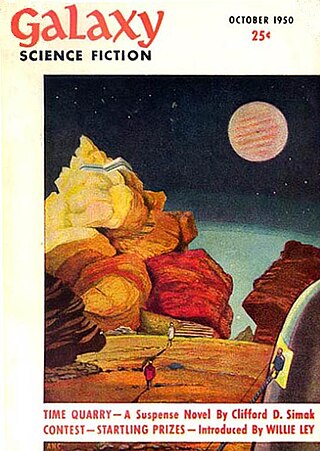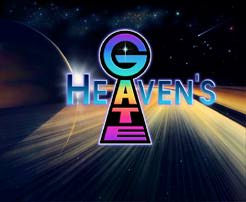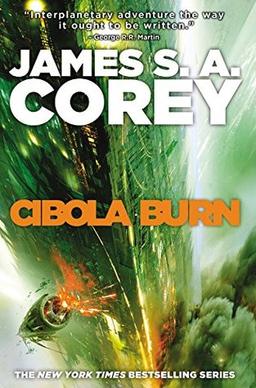Grey aliens, also referred to as Zeta Reticulans, Roswell Greys or Grays, are purported extraterrestrial beings. They are frequent subjects of close encounters and alien abduction claims. The details of such claims vary widely. However, Greys are typically described as being human-like with small bodies, smooth, grey-colored skin; enlarged, hairless heads; and large, black eyes. The Barney and Betty Hill abduction claim, which purportedly took place in New Hampshire in 1961, popularized Grey aliens. Precursor figures have been described in science fiction and similar descriptions appeared in early accounts of the 1948 Aztec UFO hoax and later accounts of the 1947 Roswell UFO incident.
Time-Flight is the seventh and final serial of the 19th season of the British science fiction television series Doctor Who, which was first broadcast in four twice-weekly parts on BBC1 from 22 to 30 March 1982.

Adam Link is a fictional robot, made in the likeness of a man, who becomes self-aware, and the protagonist of several science fiction short stories written by Eando Binder, the pen name of Earl Andrew Binder and his brother, Otto Binder. The stories were originally published in the science fiction magazine Amazing Stories from 1939 to 1942. In all, ten Adam Link stories were published. In The American Robot: A Cultural History, Dustin A. Abnet says that Adam was the "most popular science fiction robot of the era".
"The Architects of Fear" is an episode of the original The Outer Limits television show. It first aired on September 30, 1963, during the first season.

"The Galaxy Being" is the first episode of the original The Outer Limits television series, originally broadcast on September 16, 1963. In it, Allan Maxwell, an engineer for a small radio station, somehow makes contact with a peaceful alien creature – the "Galaxy Being" – who is then transported to Earth by accident. The Galaxy Being inadvertently kills several people with its natural radiation, and is met with violence and hysteria from the people of Earth.
"Corpus Earthling" is an episode of the original The Outer Limits television show. It first aired on 18 November 1963, during the first season.

"Nightmare" is an episode of the original The Outer Limits television show. It first aired on 2 December 1963, during the first season.
"Demon with a Glass Hand" is an episode of the American television series The Outer Limits, the second to be based on a script by Harlan Ellison, which Ellison wrote specifically with actor Robert Culp in mind for the lead role. It originally aired on October 17, 1964, and was the fifth episode of the second season. In 2009, TV Guide ranked "Demon with a Glass Hand" #73 on its list of the 100 Greatest Episodes.
"Second Chance" is an episode of the original The Outer Limits television show. It first aired on March 2, 1964, during the first season.

"Moonstone" is an episode of the original The Outer Limits television show. It first aired on 9 March 1964, during the first season.
"The Guests" is an episode of the original The Outer Limits television show. It first aired on March 23, 1964, during the first season.
"The Inheritors" is the only two-part episode of the original The Outer Limits television show. It comprises the forty-first and forty-second episodes of the show, in the second season. Part I was first aired on November 21, 1964; Part II on November 28, 1964.

His Master's Voice is a 1960s science fiction novel written by Polish writer Stanisław Lem. It was first published in 1968 and translated into English by Michael Kandel in 1983. The book incorporates a "message from space" theme. It is a densely philosophical first contact story about an effort by scientists to decode, translate, and understand an extraterrestrial transmission. The novel critically approaches humanity's intelligence and intentions in deciphering and truly comprehending a message from outer space. It is considered to be one of the three best-known books by Lem, the other two being Solaris and The Cyberiad.

The planetary systems of stars other than the Sun and the Solar System are a staple element in many works of the science fiction genre.

Ancient astronauts have been addressed frequently in science fiction and horror fiction. Occurrences in the genres include:

Heaven's Gate was an American new religious movement known primarily for the mass suicides committed by its members in 1997. Commonly designated a cult, it was founded in 1974 and led by Bonnie Nettles (1927–1985) and Marshall Applewhite (1931–1997), known within the movement as Ti and Do, respectively. Nettles and Applewhite first met in 1972 and went on a journey of spiritual discovery, identifying themselves as the two witnesses of Revelation, attracting a following of several hundred people in the mid-1970s. In 1976, a core group of a few dozen members stopped recruiting and instituted a monastic lifestyle.

The Outer Limits is an American television series that was broadcast on ABC from September 16, 1963, to January 16, 1965, at 7:30 PM Eastern Time on Mondays. It is often compared to The Twilight Zone, but with a greater emphasis on science fiction stories. It is an anthology of self-contained episodes, sometimes with plot twists at their ends.

Cibola Burn is a 2014 science fiction novel by James S. A. Corey and the fourth book in The Expanse series. It follows the crew of the Rocinante as they join the flood of humanity out into the galaxy, using the gates built by the ancient civilization which also produced the protomolecule. Cibola Burn is heavily influenced by western stories, departing slightly from the previous themes of the series to tell a story of survival on the frontier. At the release of Cibola Burn, Orbit Books announced that James S. A. Corey would write three additional books in the series to bring the series to nine novels and various short stories. Cibola Burn serves as the basis for the fourth season of the television series The Expanse, which was released by Amazon Video December 13, 2019.
Jeffrey Scott Frentzen, sometimes credited as Jeff Frentzen, is an American movie director, screenwriter, producer, novelist, journalist, and actor.









